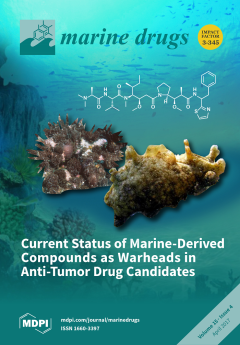A new sterol, (23
R)-methoxycholest-5,24-dien-3β-ol (
1), two new ceramides, (2
S,3
R,4
E,8
E)-2-(tetradecanoylamino)-4,8-octadecadien-l,3-diol (
6) and (2
S,3
R,2′
R,4
E,8
E)-2-(tetradecanoylamino)-4,8-octadecadien-l,3,2′-triol (
7), together with three known
[...] Read more.
A new sterol, (23
R)-methoxycholest-5,24-dien-3β-ol (
1), two new ceramides, (2
S,3
R,4
E,8
E)-2-(tetradecanoylamino)-4,8-octadecadien-l,3-diol (
6) and (2
S,3
R,2′
R,4
E,8
E)-2-(tetradecanoylamino)-4,8-octadecadien-l,3,2′-triol (
7), together with three known sterols (
2–
4), a lactone (
5) and two ceramides (
8,
9), were isolated from the marine bryozoan
Cryptosula pallasiana, collected at Huang Island of China. The structures of the new compounds were elucidated by extensive spectroscopic analyses, chemical methods and quantum electronic circular dichroism (ECD) calculations. Among the isolated compounds, sterol
1 possessed a rare side chain with a methoxy group at C-23, and a double bond between C-24 and C-25. Ceramides
6 and
7 possessed 14 carbons in their long-chain fatty acid base (FAB), which were different from the normal ceramides with 16 carbons in the FAB. Moreover, compounds
5 and
8 were isolated for the first time from marine bryozoans. Compounds
1–
9 were evaluated for their cytotoxicity against human tumor cell lines HL-60, Hep-G2 and SGC-7901. The results showed that lactone
5 appears to have strong cytotoxicity against the test tumor cell lines, with IC
50 values from 4.12 μM to 7.32 μM, and sterol
1 displayed moderate cytotoxicity with IC
50 values between 12.34 μM and 18.37 μM, while ceramides
6–
9 showed weak cytotoxicity with IC
50 ranging from 21.13 μM to 58.15 μM.
Full article






